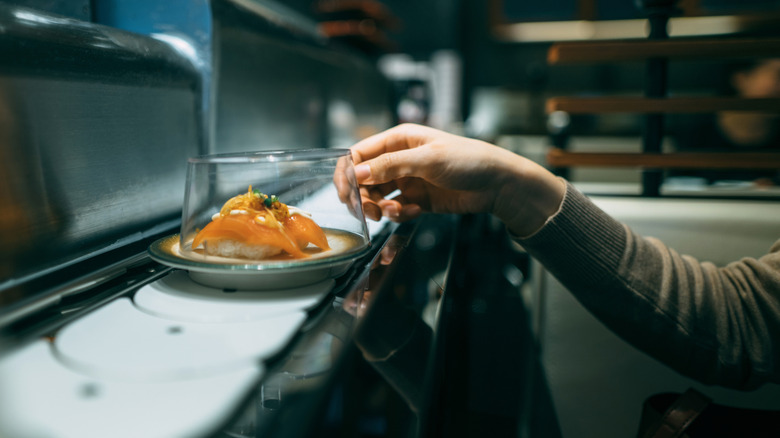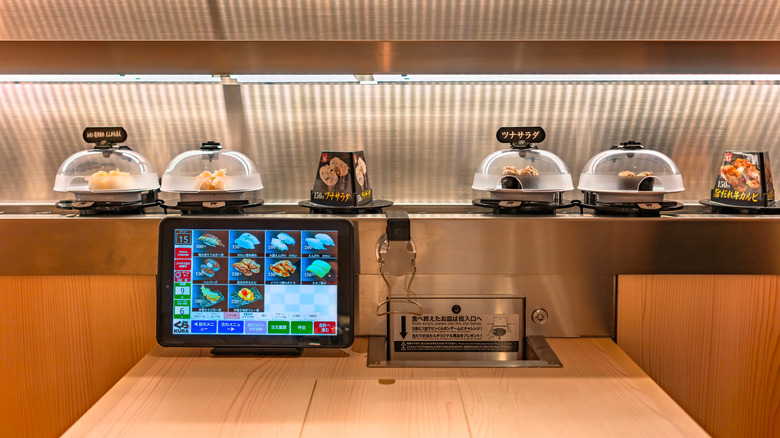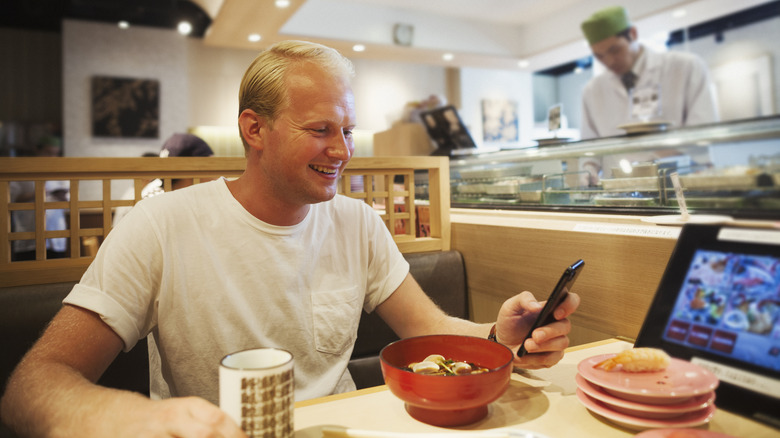The High-Tech Way Some Conveyor Belt Sushi Places Make Sure Their Revolving Fish Is Fresh
Sushi is a dish best served fresh, and in the most ideal (and fanciest) cases, a highly trained chef will deposit each piece directly onto your plate as soon as they've finished shaping it. But high-end restaurants aren't the only place you can eat sushi — you can also go to conveyor belt sushi bars (aka kaiten-zushi). And while you can't expect the same level of quality at these budget joints, freshness is still a strict requirement. Kaiten-zushi chains in Japan are big on developing proprietary solutions to maintain freshness, and some of them are quite high-tech.
For example, Kura Sushi (which has over 75 branches in the United States) uses hands-free, ventilated, and antibacterial sushi covers along with QR codes and an AI camera system to protect and monitor food while it circles the restaurant on the conveyor belt. The camera keeps track of how many plates are on the belt, which table takes them, and even watches out for unsanitary behavior from customers.
With this level of monitoring, restaurants can make sure the belt always has an optimal amount and mix of sushi available — and they can remove any plates that have sat for too long or been tampered with by misbehaving customers. The last feature was added just a few years ago after a series of scandals involving unsanitary pranks at various sushi chains in Japan.
Why Kura Sushi's covers are so special
Kura Sushi wasn't the first company to use sushi covers — they've already existed for quite a while. However, they were far from ideal. Customers had to lift the cover every time they took a piece of sushi, causing them to get dirty quickly — sometimes to the point where you couldn't see the contents through the plastic.
Kura Sushi decided there had to be a better solution. In 2011, it developed a hands-free sushi cover called Mr. Fresh (Sendo-kun, in Japanese). The plastic dome covering the sushi meets ISO 22196 antibacterial standards and it has a small opening at the front to allow customers to grab the plate. As soon as they do, the cover pops open. This improved system keeps the sushi protected from contaminants and keeps the cover clean. Combined with the plate-tracking camera system, Kura Sushi ensures its revolving food stays fresh and appetizing for as long as possible.
Other strategies that keep conveyor belt sushi fresh
Kura Sushi's solutions are all focused on maintaining the "revolving" aspect of conveyor belt sushi — but this isn't the only option. Other kaiten-zushi restaurants have "express lane" conveyor belts which deliver food directly to customers when they order via the tablet at their table. When you order this way, other people can't touch your food, and it only stays on the conveyor belt for a few seconds, so it's fresh by default.
Because of these benefits, some chains, such as Hamazushi, completely dropped their revolving conveyor belts and switched to an order-only system. I personally think this is a much better model. Even when I eat at chains with revolving belts, I still only use the express lane. It's much more enjoyable to just order your sushi and chat while you wait, rather than have to watch the conveyor belt like a hawk so you don't miss the next plate of flamed salmon nigiri.
Plus, what if the monitoring system bugs out? The longer sushi sits on the belt at room temperature, the more likely it is for bacteria to multiply in the rice and cause food poisoning. I don't want to take that risk. If you ask me, the express lane is the way forward when it comes to kaiten-zushi, and it's fairly high-tech in its own way.


